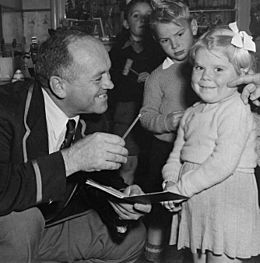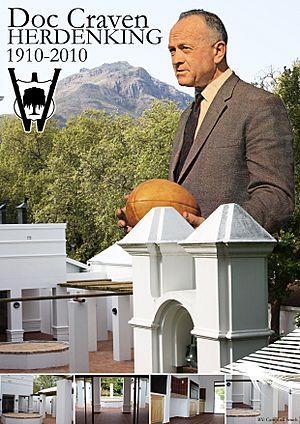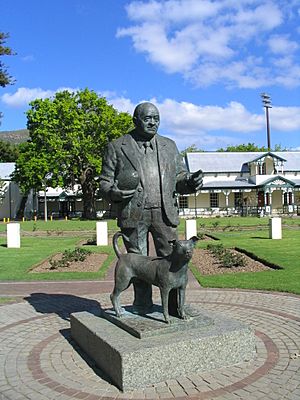Danie Craven facts for kids

Craven in New Zealand in 1956
|
|||||||||||||||||||||||||||||||||||||||||||||||||||||
| Birth name | Daniël Hartman Craven | ||||||||||||||||||||||||||||||||||||||||||||||||||||
|---|---|---|---|---|---|---|---|---|---|---|---|---|---|---|---|---|---|---|---|---|---|---|---|---|---|---|---|---|---|---|---|---|---|---|---|---|---|---|---|---|---|---|---|---|---|---|---|---|---|---|---|---|---|
| Date of birth | 11 October 1910 | ||||||||||||||||||||||||||||||||||||||||||||||||||||
| Place of birth | Lindley, Free State, South Africa | ||||||||||||||||||||||||||||||||||||||||||||||||||||
| Date of death | 4 January 1993 (aged 82) | ||||||||||||||||||||||||||||||||||||||||||||||||||||
| Place of death | Stellenbosch, South Africa | ||||||||||||||||||||||||||||||||||||||||||||||||||||
| Height | 1.78 m (5 ft 10 in) | ||||||||||||||||||||||||||||||||||||||||||||||||||||
| Weight | 80 kg (176 lb) | ||||||||||||||||||||||||||||||||||||||||||||||||||||
| School | Lindley High School | ||||||||||||||||||||||||||||||||||||||||||||||||||||
| University | Stellenbosch University | ||||||||||||||||||||||||||||||||||||||||||||||||||||
| Occupation(s) | President of South African Rugby ('56–'93) Director of Sport ('76–'84) Professor of Physical Education ('49–'75) |
||||||||||||||||||||||||||||||||||||||||||||||||||||
| Rugby union career | |||||||||||||||||||||||||||||||||||||||||||||||||||||
|
|||||||||||||||||||||||||||||||||||||||||||||||||||||
Daniël Hartman Craven (born October 11, 1910 – died January 4, 1993) was a famous South African rugby union player, coach, and leader. People often called him Danie, Doc, or Mr. Rugby. He was known for his amazing "dive-pass" as a scrum-half. He also played other positions like centre and fly-half.
Craven coached the Springboks (South Africa's national team) from 1949 to 1956. During this time, the team won most of their games, making it a very successful period for South African rugby. He then became the longest-serving President of the South African Rugby Board (SARB) from 1956 to 1993. He also led the International Rugby Board several times.
Danie Craven earned advanced degrees in different subjects like ethnology (the study of cultures), psychology (the study of the mind), and physical education (the study of exercise). He even helped create the physical training part of the South African army. Later, he became the first professor of physical education at Stellenbosch University.
Contents
Early Life and School
Danie Craven was born on October 11, 1910, on a farm near Lindley, a small town in South Africa. He was one of seven children. His family's farm was named after a place in England where his grandfather came from. Danie's father fought in the Second Boer War against the British.
As a young boy, Danie played soccer without shoes. He learned at a farm school. At 13, he went to Lindley High School and started playing rugby with a stone in the dusty streets. He was very good at both cricket and rugby. The next year, he was chosen for the town's adult rugby team. However, his principal said he couldn't play until he was 15 years old.
Education and Teaching
In 1929, Craven went to Stellenbosch University. He first studied to be a priest but changed to Social Sciences and Social Anthropology. This change happened after he hurt his throat during a rugby game in 1932.
At university, Craven lived in the Wilgenhof Men's Residence. He was a great athlete and played rugby, swam (he was captain), played water polo, and baseball. He also did track and field, cricket, tennis, and soccer.
Craven earned several degrees from Stellenbosch University, including a PhD in ethnology. His PhD was about how South African groups were classified. He later became the first professor of physical education at Stellenbosch in 1949, and he taught there until 1975.
After university, Craven taught at St. Andrew's College in Grahamstown in 1936. He coached the school's rugby team there.
In 1938, Craven joined the army to lead physical education. He traveled to Europe to learn about physical training in different countries. When World War II was about to start, he returned to South Africa. He became a major and later a lieutenant-colonel in charge of physical training for the army. Because he was a famous rugby player, his picture was used in newspapers to encourage men to join the army during the war.
Rugby Playing Career
At Stellenbosch University, Danie Craven found a mentor in coach A.F. Markötter. Markötter was in charge of the university team for many years. He saw Craven play when he was 19 and moved him to the main team the next year.
Provincial Games
Craven was chosen to be a Springbok in 1931, even before he played his first provincial game for Western Province in 1932. In a game against Free State that year, he scored three tries. This was one of his best performances.
In 1936, he played for Eastern Province. He suggested that another player, Flappie Lochner, should go on the 1937 tour to New Zealand, and Markötter made sure it happened.
International Games
Craven played his first international test match on December 5, 1931. He was 21 years old and played as a scrum-half against Wales. Even though the field was wet and muddy, he played so well that a newspaper said, "Boy plays like a giant."
In his third test, against Scotland in 1932, Craven scored the winning try. He used advice from his university coach, Markötter, about playing on a muddy field. During that game, he was knocked out, hurt his voice, and lost a tooth.
Craven's last test match was on September 10, 1938. He was 27 and captained the team as a scrum-half against the British and Irish Lions. He was one of the best scrum-halves in the world during the 1930s. However, World War II started in 1939, which ended his playing career early.
Test Match History
| Opponents | Results (RSA 1st) | Position | Points | Dates | Venue |
|---|---|---|---|---|---|
| Wales | 8–3 | Scrum-half | – | 5 December 1931 | St Helen's, Swansea |
| Ireland | 8–3 | Scrum-half | – | 19 December 1931 | Lansdowne Road, Dublin |
| Scotland | 6–3 | Scrum-half | 3 (try) | 16 January 1932 | Murrayfield, Edinburgh |
| Australia | 17–3 | Scrum-half | 3 (try) | 8 July 1933 | Newlands, Cape Town |
| Australia | 6–21 | Scrum-half | - | 22 July 1933 | Kingsmead, Durban |
| Australia | 12–3 | Scrum-half | - | 12 August 1933 | Ellis Park, Johannesburg |
| Australia | 11–0 | Centre | - | 26 August 1933 | Crusaders Grounds, Port Elizabeth |
| Australia | 4–15 | Scrum-half | - | 2 September 1933 | Springbok Park, Bloemfontein |
| Australia | 9–5 | Fly-half | - | 26 June 1937 | Sydney Cricket Ground |
| Australia | 26–17 | No. 8 | - | 17 July 1937 | Sydney Cricket Ground |
| New Zealand | 7–13 | Fly-half (C) | - | 14 August 1937 | Athletic Park, Wellington |
| New Zealand | 13–6 | Scrum-half | - | 4 September 1937 | Lancaster Park, Christchurch |
| New Zealand | 17–6 | Scrum-half | - | 25 September 1937 | Eden Park, Auckland |
| Great Britain | 26–12 | Scrum-half (C) | - | 6 August 1938 | Ellis Park, Johannesburg |
| Great Britain | 19–3 | Scrum-half (C) | - | 3 September 1938 | Crusaders Grounds, Port Elizabeth |
| Great Britain | 16–21 | Scrum-half (C) | - | 10 September 1938 | Newlands, Cape Town |
Rugby Coaching and Leadership
Coaching Career
After his playing days, Danie Craven became a national selector in 1938. Then, in 1949, he became the coach of the Springboks. He started with a great winning streak, including beating New Zealand 4–0 in their 1949 tour. Under his coaching, the Springboks were undefeated from 1949 to 1952. They won 17 out of 23 test matches, which is a 74% success rate. This makes Craven one of South Africa's best rugby coaches ever. He also coached Stellenbosch University from 1949 to 1956.
Leading Rugby
Craven became the president of the South African Rugby Board (SARB) in 1956. He was also a member of the International Rugby Board (IRB) from 1957 and was its chairman many times.
Craven's time leading the SARB was during a difficult period in South Africa. The country had a system called apartheid, which separated people based on race. Many countries stopped playing sports with South Africa to protest this system. Rugby was very important to many white South Africans, and the ban on international games was upsetting for them.
Craven worked hard to keep connections with other rugby nations during this time. He worried that not playing international games would make the Springbok team weaker. He tried to find ways for South Africa to still play.
In 1988, Craven met with leaders of the African National Congress (ANC) in Zimbabwe. The ANC was a group fighting against apartheid. They made a plan to create one rugby association in South Africa that would include all races. This was a very brave step. Some white South Africans were angry with Craven for meeting the ANC. However, this meeting helped pave the way for a united rugby body, the South African Rugby Football Union (SARFU), which was formed in 1992. Craven was the first chairman of SARFU until he passed away in 1993. He had led South African rugby for 37 years.
Personal Life
Danie Craven was married twice. His first wife was Beyera Johanna Hayward, whom he married in 1938. They had four children: Joan, George, Daniel, and James. One of his grandsons, Dan Craven, is a professional cyclist from Namibia. Danie and Beyera divorced in 1972.
In 1975, Craven married Martha Jacoba (Merlė) Vermeulen. Merlė worked in fashion. She hurt her ankle once, and someone introduced her to Craven, saying he was a "doctor" who knew about ankle injuries. Craven helped her, and they later started a relationship and got married.
Craven had a dog named Bliksem, who went everywhere with him, even to rugby practices. People said that when Doc and Bliksem were watching practice, no one dared to be lazy.
Legacy
Honours
Danie Craven was honored in the International Rugby Hall of Fame in 1997. He was the first of many South Africans to receive this honor. In 2007, he was also inducted into the IRB Hall of Fame.
The South African Craven Week schools rugby competition is named after him. The Danie Craven Stadium and the Danie Craven Rugby Museum in Stellenbosch are also named in his honor. There is a bronze statue of Craven and his loyal dog, Bliksem, at the Coetzenburg sports complex in Stellenbosch.
In 1981, Craven received a special award from the State President for his outstanding service. He was also made an honorary citizen of Stellenbosch. In 1992, he became an honorary life president of the French Rugby Federation.
Famous Sayings
Craven was known for his unique and sometimes controversial statements. For example, he once said, "When Maties and Western Province rugby are strong, then Springbok rugby is strong." This meant that strong local teams made the national team strong.
He also worked to unite rugby in South Africa. He denied ever saying that people of color would only play for the Springboks "over my dead body." In his later years, he worked hard to hold rugby workshops for all races in rural areas, showing his commitment to bringing people together through rugby.
Books He Wrote
Danie Craven wrote many books about rugby. His book Rugby Handbook (1970) is considered a very important guide for coaches. He also wrote his autobiography in 1949.
Here are a few of his books:
- Ons rugby op die platteland (Our Rugby in the Countryside)
- Rugby vir almal (Rugby for Everyone)
- Rugby handboek (Rugby Handbook)
- Die verhaal van rugby (The Story of Rugby)
- The Seven Pillars of Rugby
- Danie Craven on Rugby
- Ek speel vir Suid-Afrika (I Play for South Africa)
See also
 In Spanish: Danie Craven para niños
In Spanish: Danie Craven para niños
- 1937 South Africa rugby union tour to Australasia
- 1951–52 South Africa rugby union tour of Europe
- 1953 Australia rugby union tour of South Africa and Rhodesia
- 1956 South Africa rugby union tour of Australia and New Zealand
- List of South Africa national rugby union players – Springbok no. 219



